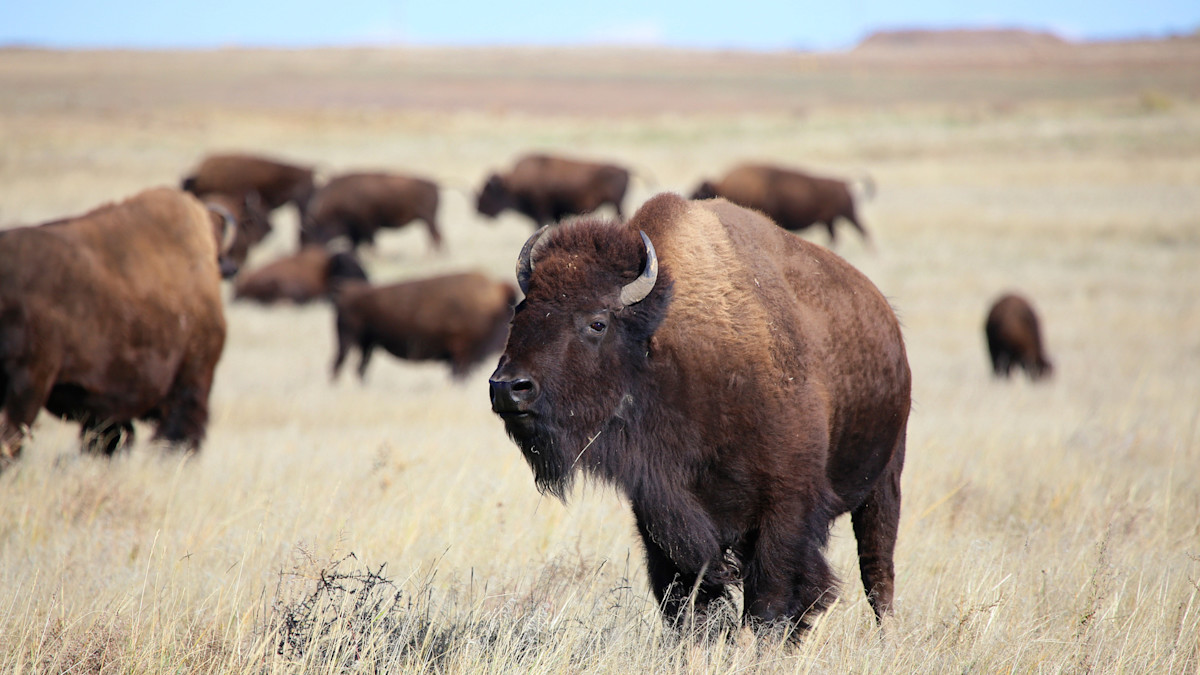Interior Department Wants More Bison on Federal and Tribal Land

Interior Secretary Deb Haaland issued a secretarial order last week aimed at increasing bison herds on federal and tribal land.
While bison restoration efforts have been ongoing at the federal level since at least 2008, this new initiative injects an additional $25 million into that project and emphasizes the Department of the Interior’s commitment to consulting with Tribal leaders.
“The American bison is inextricably intertwined with Indigenous culture, grassland ecology, and American history,” Haaland said in a statement. “While the overall recovery of bison over the last 130 years is a conservation success story, significant work remains to not only ensure that bison will remain a viable species but also to restore grassland ecosystems, strengthen rural economies dependent on grassland health and provide for the return of bison to Tribally owned and ancestral lands.”
The order tasks the Bison Working Group with developing a Department Bison Shared Stewardship Plan. This plan will establish a comprehensive framework for American bison restoration aimed at restoring wide-ranging herds on large tracts of land.
The plan must adhere to five additional principles, among which are respect for “livestock health, private property rights, Tribal sovereignty, and state interests,” along with the inclusion of “Indigenous Knowledge” in bison management. The plan must also prioritize tribally-led opportunities to establish new, large herds, and reserves a seat on the Bison Working Group for a “tribal leader.”
The ranching community has historically opposed efforts to increase bison herds on federal land. In Montana, ranchers pushed back on bison reintroduction in the Charles M. Russell National Wildlife Refuge. They worry that the bison will compete with livestock for public grazing space and spread brucellosis, a contagious bacterial disease that causes loss of young through spontaneous abortion.
The Montana state senate passed a resolution last week opposing the reintroduction of bison on the Charles M. Russell National Wildlife Refuge (CMR). “The placement of bison on the CMR would jeopardize critical grazing land for livestock, greatly increase the threat of disease transmission between livestock and wildlife, threaten the livelihoods of ranching families, and impair the State of Montana's management of state trust land,” the resolution reads.
Haaland’s order attempts to address these concerns by directing the Bison Working Group to “manage bison health to address the risks that disease in bison may pose to human health, domestic animals, or other wildlife.”
Some conservation and hunting groups are applauding the move as part of a larger strategy for restoring grasslands. Backcountry Hunters and Anglers released a statement arguing that the order “anchors public land conservation both immediately and in the longer term.”
BHA President and CEO Land Tawney said it’s time to “double down and turn our collective attention to the American bison,” which he called “a capstone on the conservation pyramid.”
There are currently about 15,000 wild bison in the United States, 11,000 of which are managed by the federal government across 4.6 million acres in 12 states. Native American Tribes manage an additional 20,000 bison. These herds live on relatively small, range-restricted parcels, but this new working group will seek to manage bison as one single, connected population.
The order lists several reasons that Haaland believes more bison should be introduced onto the landscape. Haaland argues that returning bison to grasslands can enhance soil development, restore native plants and wildlife, and promote carbon sequestration. These efforts, she says, can help mitigate climate change and restore grassland ecosystems.
There is also a cultural and social component that she says will benefit Native American tribes. “Restoring bison and healthy grasslands can serve as a step toward national healing and reconciliation after centuries of federal policies designed to erase Native people and their cultures,” she says in the order.
About $25 million from last year’s Inflation Reduction Act will be set aside to implement whatever plan the working group comes up with. About half of that will go to the National Park Service with the remainder going to the other agencies that help manage bison. The Working Group will include members from the Park Service, the U.S. Fish and Wildlife Service (FWS), the Bureau of Indian Affairs (BIA), the Bureau of Land Management (BLM), and the U.S. Geological Survey (USGS).
The order requires the Bison Working Group to submit a draft of the Stewardship Plan by December 31, 2023.





